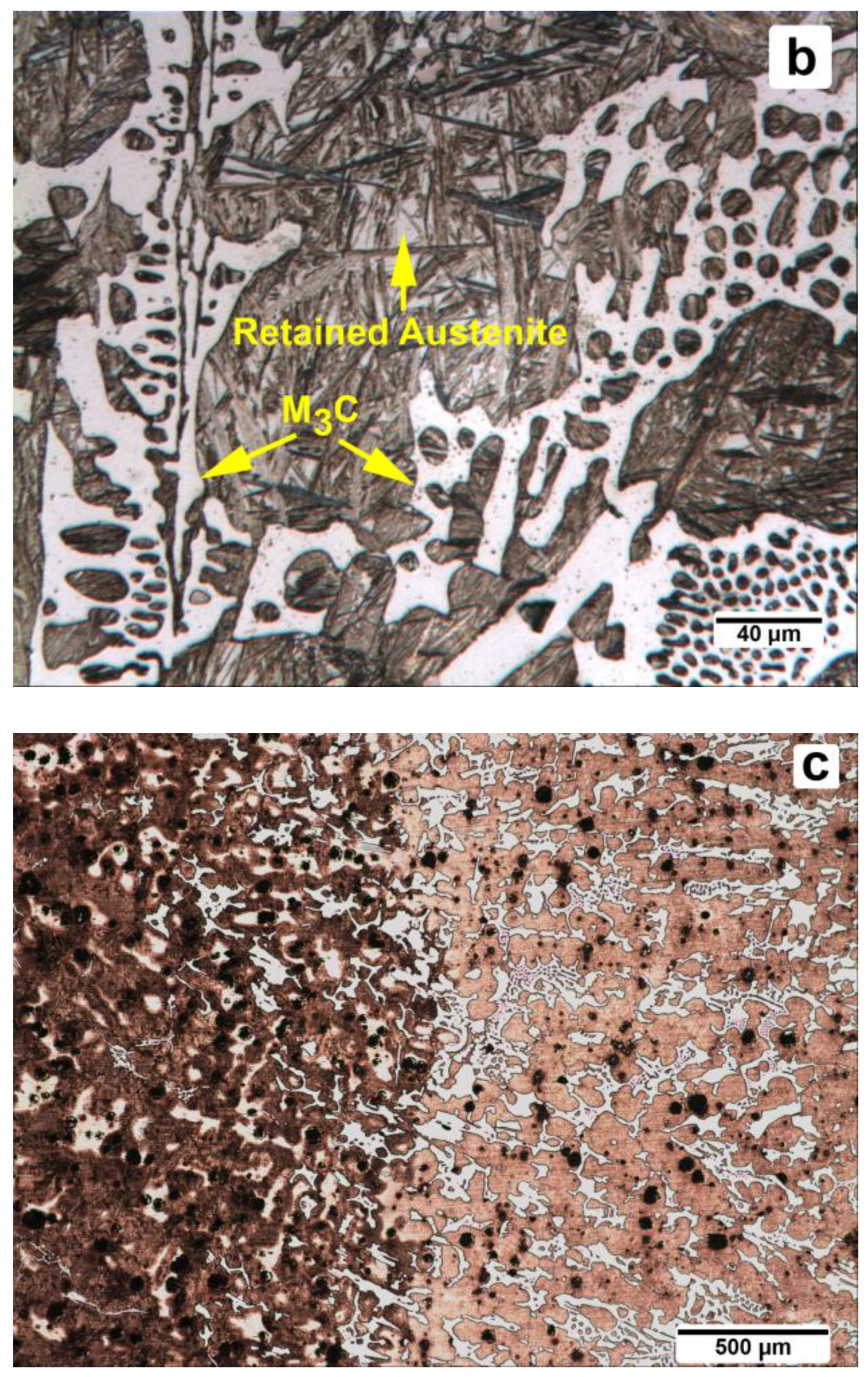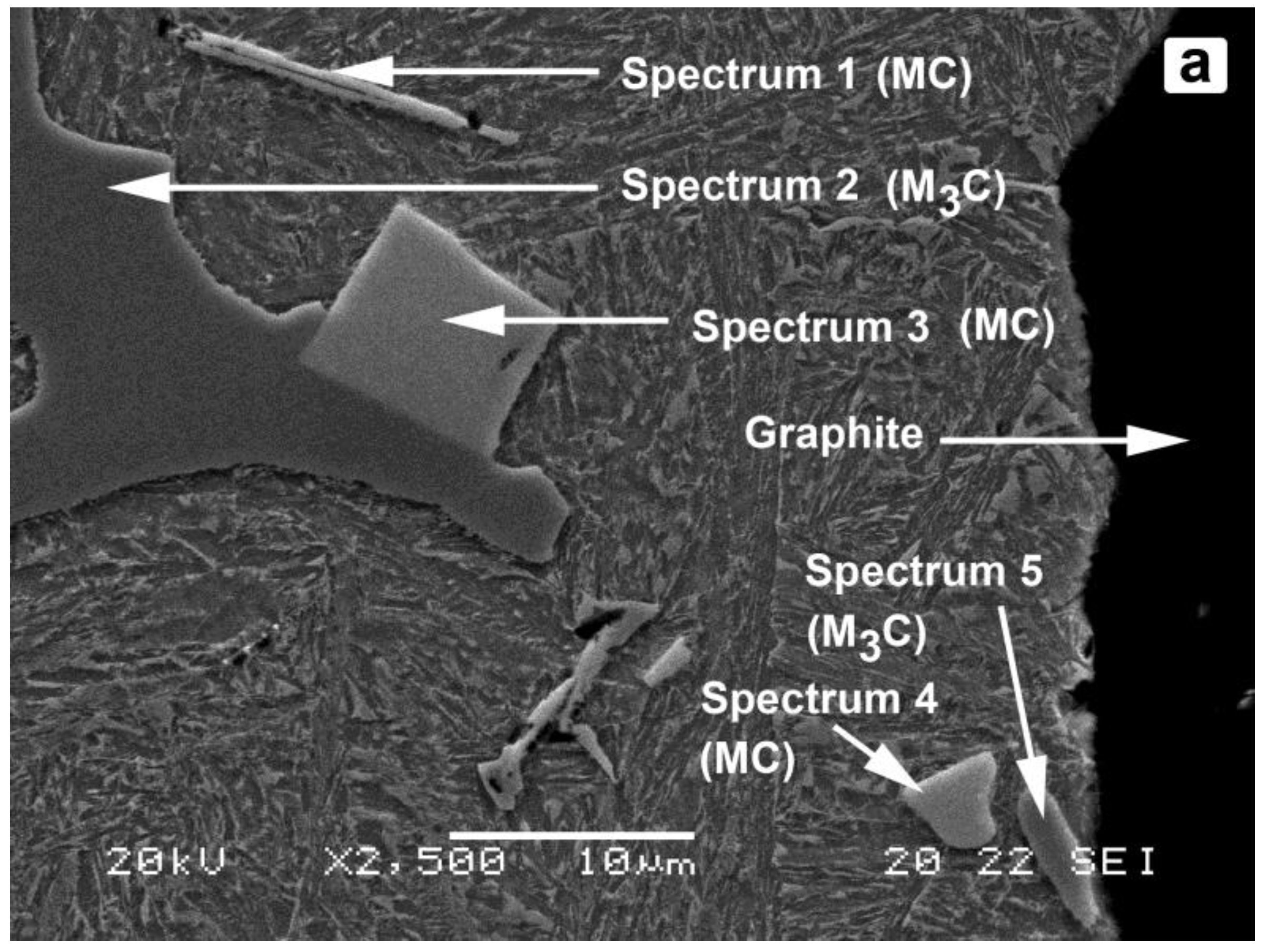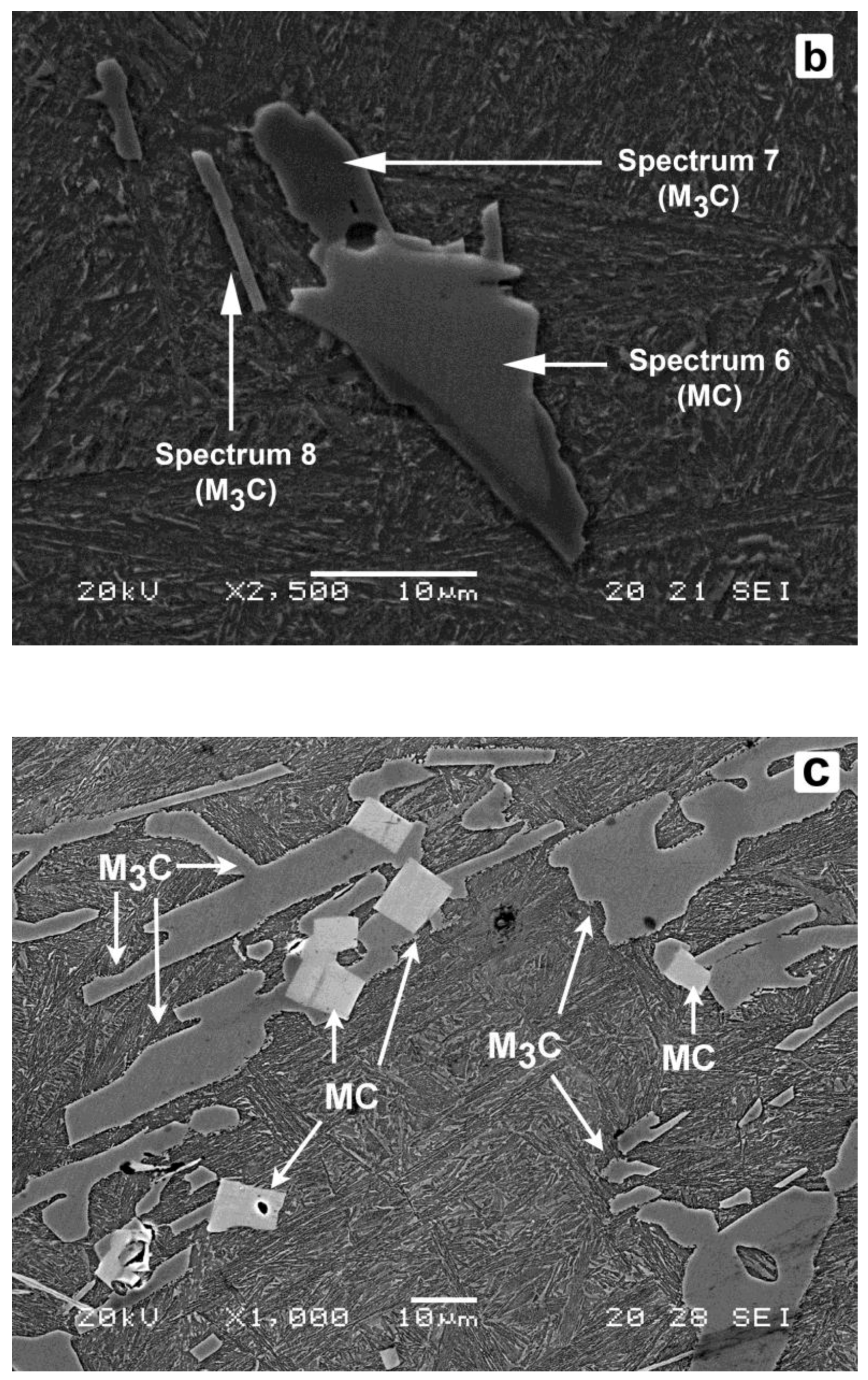Enhanced Fracture Strength in the Working Layer of Rolls Manufactured in Ni-Hard Cast Iron Alloyed with Mo, Nb and Mg
Abstract
1. Introduction
2. Materials and Methods
3. Results
4. Conclusions
- Inoculation with SiCa has a positive effect on the toughness of the material and seems to confirm its tendency to break up the carbide network.
- Inoculation with FeB promotes heterogeneous nucleation of the NbC, but also reduces flexural strength and does not have a significant effect on the hardness of the material.
- The addition of Mg leads to an improvement in flexural strength.
- Mo remains in solid austenite solution, favouring the hardenability of the material.
- (1)
- Set the liquidus temperature within the 1270–1275 °C range
- (2)
- Inoculate with 3 kg/T FeB
- (3)
- Inoculate with 0.6 kg/T SiCa
- (4)
- Inoculate with Mg.
Author Contributions
Funding
Conflicts of Interest
References
- Bravo, S.V.; Yamamoto, K.; Miyahara, H.; Ogi, K. Control of carbides and graphite in Ni-hard type cast iron for hot strip mills. Mater. Sci. Forum 2007, 561–565, 1023–1026. [Google Scholar] [CrossRef]
- Vadiraj, A.; Balachandran, G.; Kamaraj, M. Effect of misch metal inoculation on microstructure, mechanical and wear properties of hypoeutectic gray cast irons. Mater. Des. 2009, 30, 4488–4492. [Google Scholar] [CrossRef]
- Sergio, V.; Shikawa, S.; Yamamoto, K.; Miyahara, H.; Ogi, K.; Kamimiyada, K. Control of graphite formation in solidification of white cast iron. Int. J. Cast Met. Res. 2008, 21, 27–30. [Google Scholar] [CrossRef]
- Gowda, D.; Kumar, D.C.; Sandeep, G.M.; Parthasarathy, A.; Chandrashekar, S. Tribological characterization of centrifugally cast graphite cast iron under dry and wet conditions. Mater. Today Proc. 2018, 5, 145–151. [Google Scholar] [CrossRef]
- Chen, H.X.; Chang, Z.C.; Lu, J.C.; Lin, H.T. Effect of niobium on wear-resistance of 15% Cr white cast iron. Wear 1993, 166, 197–201. [Google Scholar] [CrossRef]
- Bedolla-Jacuinde, A. Microstructure of vanadium-, niobium- and titanium-alloyed high-chromium white cast irons. Int. J. Cast Met. Res. 2001, 13, 343–361. [Google Scholar] [CrossRef]
- Filipovic, M.; Kamberovic, Z.; Korac, M.; Jordovic, B. Effect of niobium and vanadium additions on the as-cast microstructure and properties of hypoeutectic Fe-Cr-C alloy. ISIJ Int. 2013, 53, 2160–2166. [Google Scholar] [CrossRef]
- Zhang, Z.G.; Yang, C.K.; Zhang, P.; Li, W. Microstructure and wear resistance of high chromium cast iron containing niobium. China Foundry 2014, 11, 179–184. [Google Scholar]
- Mourad, M.M.; El-Hadad, S.; Ibrahim, M.M. Effects of molybdenum addition on the microstructure and mechanical properties of ni-hard white cast iron. Trans. Indian Inst. Met. 2015, 68, 715–722. [Google Scholar] [CrossRef]
- Noda, N.A.; Hu, K.; Sano, Y.; Ono, K.; Hosokawa, Y. Residual stress simulation for hot strip bimetallic roll during quenching. Steel Res. Int. 2016, 87, 1478–1488. [Google Scholar] [CrossRef]
- Belzunce, F.J.; Ziadi, A.; Rodriguez, C. Structural integrity of hot strip mill rolling rolls. Eng. Fail. Anal. 2004, 11, 789–797. [Google Scholar] [CrossRef]
- Drobne, M.; Urska, K.; Tercelj, M.; Fajfar, P.; Ltd, T. Thermal crack propagation during hot rolling and its influence on cast iron work roll degradation. In Proceedings of the Metal 2017: 26th International Conference on Metallurgy and Materials, Brno, Czech Republic, 24–26 May 2017. [Google Scholar]
- Jonck, J.; Moema, J.S.; Jooste, J.; van Tonder, P. Investigation of the ‘tiger skin’ defect on indefinite chill rolls. J. South. Afr. Inst. Min. Metall. 2016, 116, 907–913. [Google Scholar] [CrossRef]
- Ray, A.; Prasad, M.S.; Dhua, S.K.; Sen, S.K.; Jha, S. Microstructural features of prematurely failed hot-strip mill work rolls: Some studies in spalling propensity. J. Mater. Eng. Perform. 2000, 9, 449–456. [Google Scholar] [CrossRef]
- Nilsson, M.; Olsson, M. An investigation of worn work roll materials used in the finishing stands of the hot strip mill for steel rolling. Proc. Inst. Mech. Eng. Part J J. Eng. Tribol. 2013, 227, 837–844. [Google Scholar] [CrossRef]
- Paar, A.; Schneider, R.; Sommitsch, C. Influence of microstructural parameters of indefinite chill alloys on flexural strength and young’s modulus. Mater. Test. 2018, 60, 239–244. [Google Scholar] [CrossRef]
- Ibrahim, M.M.; El-Hadad, S.; Mourad, M. Enhancement of wear resistance and impact toughness of as cast hypoeutectic high chromium cast iron using niobium. Int. J. Cast Met. Res. 2018, 31, 72–79. [Google Scholar] [CrossRef]
- Col, M.; Koc, F.G.; Oktem, H.; Kir, D. The role of boron content in high alloy white cast iron (Ni-hard 4) on microstructure, mechanical properties and wear resistance. Wear 2016, 348–349, 158–165. [Google Scholar] [CrossRef]
- Iacoviello, F.; Iacoviello, D.; Di Cocco, V.; De Santis, A.; D’Agostino, L. Classification of ductile cast iron specimens based on image analysis and support vector machine. Procedia Struct. Integr. 2017, 3, 283–290. [Google Scholar] [CrossRef]
- Takeda, H.; Yoneda, H.; Asano, K. Effect of silicon and bismuth on solidification structure of thin wall spheroidal graphite cast iron. Mater. Trans. 2010, 51, 176–185. [Google Scholar] [CrossRef]
- Dun, X.L.; Liu, K.P.; Liu, H.S.; Lai, J.P.; Fu, X.H.; Zhou, J. Effect of multicomponent modifier on microstructure and mechanical properties of high Ni-Cr-Mo cast iron. Mater. Sci. Technol. 2011, 27, 1840–1845. [Google Scholar] [CrossRef]
- Radulovic, M.; Fiset, M.; Peev, K. Effect of rare-earth elements on microstructure and properties of high chromium white iron. Mater. Sci. Technol. 1994, 10, 1057–1062. [Google Scholar] [CrossRef]
- Prat, A.; Tort-Martorell, X.; Grima, P.; Pozueta, L. Métodos Estadísticos. Control y Mejora de la Calidad, 2nd ed.; Universidad Politécnica de Cataluña (UPC): Barcelona, Spain, 1997; pp. 165–195. ISBN 9788498802320. [Google Scholar]
- Romero, R.; Zúnica, L.R. Métodos Estadísticos en Ingeniería; Universidad Politécnica de Valencia: Valencia, Spain, 2005; pp. 275–278. ISBN 9788497057271. [Google Scholar]
- Johnson, R. Probabilidad y Estadística para Ingenieros, 3rd ed.; Prentice-Hall Hispanoamérica: México DF, México, 1997; pp. 489–494. ISBN 9688809616. [Google Scholar]
- Box, G.E.P.; Hunter, W.G.; Hunter, J.S. Estadística Para Investigadores: diseño, Innovación Y Descubrimiento, 2nd ed.; Reverté: Barcelona; Spain, 2008; pp. 235–273. ISBN 9788429150445. [Google Scholar]
- Song, J.M.; Lui, T.S.; Chen, L.H. Effect of carbon equivalent and spheroidizer addition on the morphology of strip cast white cast iron plate. Int. J. Cast Met. Res. 1999, 12, 83–91. [Google Scholar] [CrossRef]








| C | Mn | Si | S | P | Cr | Ni | Mo | Nb |
|---|---|---|---|---|---|---|---|---|
| 3.2–3.4 | 0.8–1.0 | 0.9–1.0 | <0.015 | <0.035 | 1.7–1.8 | 4.4–4.6 | 0.25 | 0.65–0.75 |
| Inoculants | Base Chemistry | ||||||||||||
|---|---|---|---|---|---|---|---|---|---|---|---|---|---|
| Si | Ca | Al | Mn | Ti | Ba | C | Bi | S | P | B | La | Fe | |
| FeSi-La | 66.0 | 2.5 | 0.8 | --- | --- | 0.3 | --- | 0.3 | --- | --- | --- | 0.8 | rem. |
| FeMn | 2.0 | --- | --- | 69.4 | --- | 5.8 | 0.014 | 0.130 | --- | rem. | |||
| SiCa | 58.3 | 16.4 | 1.1 | 14.8 | 0.030 | 0.6 | 0.030 | 0.030 | --- | rem. | |||
| FeB | 0.4 | --- | --- | --- | --- | 0.3 | --- | --- | 17.9 | rem. | |||
| Factors | Levels | ||
|---|---|---|---|
| Code | Metallurgical Parameter Correspondence | Level −1 | Level +1 |
| A | FeSi-La (Kg/T) | 0 | 2.7 |
| B | FeB (Kg/T) | 3 | 6 |
| C | Liquidus Temperature (°C) | 1250–1255 | 1270–1275 |
| D | Si (%) | 0.8–0.85 | 1.1–1.15 |
| E | SiCa (Kg/T) | 0.3 | 0.6 |
| F | Mg (%) | 0 | 0.02 |
| No. | A | B | C | D | E | F |
|---|---|---|---|---|---|---|
| 1 | –1 | –1 | –1 | +1 | +1 | +1 |
| 2 | +1 | –1 | –1 | –1 | –1 | +1 |
| 3 | –1 | +1 | –1 | –1 | +1 | –1 |
| 4 | +1 | +1 | –1 | +1 | –1 | –1 |
| 5 | –1 | –1 | +1 | +1 | –1 | –1 |
| 6 | +1 | –1 | +1 | –1 | +1 | –1 |
| 7 | –1 | +1 | +1 | –1 | –1 | +1 |
| 8 | +1 | +1 | +1 | +1 | +1 | +1 |
| Generators | Confounders |
|---|---|
| D = AB E = AC F = BC | A + BD + CE |
| B + AD + CF | |
| C + AE + BF | |
| D + AB + EF | |
| E + AC + DF | |
| F + BC + DE |
| Casting Parameters | Units | Experiment Number | |||||||
|---|---|---|---|---|---|---|---|---|---|
| 1 | 2 | 3 | 4 | 5 | 6 | 7 | 8 | ||
| C | % | 3.35 | 3.46 | 3.4 | 3.28 | 2.94 | 3.04 | 3.02 | 3.04 |
| Mn | % | 0.77 | 0.78 | 0.79 | 0.77 | 0.79 | 0.83 | 0.80 | 0.82 |
| Si | % | 1.13 | 0.88 | 0.87 | 1.18 | 1.16 | 0.89 | 0.87 | 1.15 |
| Cr | % | 1.68 | 1.68 | 1.71 | 1.64 | 1.65 | 1.71 | 1.68 | 1.71 |
| Ni | % | 4.44 | 4.33 | 4.32 | 4.38 | 4.59 | 4.16 | 4.62 | 4.65 |
| Mo | % | 0.26 | 0.25 | 0.25 | 0.24 | 0.25 | 0.25 | 0.26 | 0.26 |
| Nb | % | 0.64 | 0.72 | 0.68 | 0.61 | 0.74 | 0.75 | 0.73 | 0.61 |
| Mg | % | 0.005 | 0.004 | -- | -- | -- | -- | 0.004 | 0.005 |
| B | % | 0.032 | 0.033 | 0.071 | 0.075 | 0.038 | 0.041 | 0.070 | 0.071 |
| La | % | -- | 0.0011 | -- | 0.0015 | -- | 0.0016 | -- | 0.0012 |
| Liquidus Temperature | °C | 1252 | 1254 | 1253 | 1250 | 1273 | 1272 | 1272 | 1270 |
| Spectrum | %B | %C | %Fe | %Nb | %Cr |
|---|---|---|---|---|---|
| 1 | 36.05 | 43.47 | 8.15 | 12.34 | -- |
| 2 | -- | 36.11 | 60.79 | -- | 3.10 |
| 3 | 45.21 | 27.29 | 20.61 | 6.88 | -- |
| 4 | 27.61 | 49.24 | 1.39 | 21.76 | -- |
| 5 | -- | 50.89 | 49.11 | -- | -- |
| 6 | 29.96 | 53.58 | 0.63 | 15.83 | -- |
| 7 | -- | 40.25 | 57.57 | -- | 2.19 |
| 8 | 30.30 | 67.48 | 2.22 |
| a). Region I | |||||
| Experiment | Charpy Test | 3-Point Bending Test | Restricted Confounding Pattern | ||
| Impact Energy (J/cm2) | Flexural Strength (MPa) | ||||
| Values | Effect 1 | Values | Effect 1 | ||
| 1 | 3.09 | 3.205 | 634.2 | 586.788 | Mean 2 |
| 2 | 2.53 | 0.075 | 582.8 | 50.725 | A/BD/CE |
| 3 | 3.11 | 0.225 | 493 | −34.275 | B/AD/CF |
| 4 | 2.86 | 0.615 | 614 | 11.575 | C/AE/BF |
| 5 | 2.97 | −0.05 | 548.3 | 25.375 | D/AB/EF |
| 6 | 3.78 | 0.48 | 650.4 | 15.925 | E/AC/DF |
| 7 | 3.5 | 0.05 | 570.2 | 20.725 | F/BC/DE |
| 8 | 3.8 | −0.205 | 601.4 | −60.825 | AF/BE/CD |
| b). Region II | |||||
| Experiment | Charpy test | 3-Point Bending Test | Restricted Confounding Pattern | ||
| Impact Energy (J/cm2) | Flexural Strength (MPa) | ||||
| Values | Effect 1 | Values | Effect 1 | ||
| 1 | 3.21 | 3.186 | 657.7 | 590.438 | Mean 2 |
| 2 | 2.69 | −0.182 | 621.3 | −34.225 | A/BD/CE |
| 3 | 3.07 | 0.002 | 479.8 | −105.025 | B/AD/CF |
| 4 | 2.67 | 0.552 | 480.4 | 61.275 | C/AE/BF |
| 5 | 3.46 | 0.117 | 627.9 | −34.525 | D/AB/EF |
| 6 | 3.38 | 0.277 | 664.9 | −16.325 | E/AC/DF |
| 7 | 3.37 | 0.082 | 664.8 | 54.375 | F/BC/DE |
| 8 | 3.64 | 0.057 | 526.7 | −53.025 | AF/BE/CD |
| a). Region I | |||||
| Experiment | Hardness (HV) | Vv Fe3C (%) | Restricted Confounding Pattern | ||
| Values | Effect 1 | Values | Effect 1 | ||
| 1 | 592 | 584.125 | 29.31 | 23.082 | Mean 2 |
| 2 | 560 | −16.75 | 28.57 | −1.985 | A/BD/CE |
| 3 | 630 | 32.25 | 25.09 | −0.705 | B/AD/CF |
| 4 | 543 | 5.75 | 20.81 | −5.725 | C/AE/BF |
| 5 | 570 | 9.25 | 20.23 | 0.685 | D/AB/EF |
| 6 | 550 | 42.75 | 15.63 | 0.525 | E/AC/DF |
| 7 | 578 | 21.75 | 21.67 | 5.285 | F/BC/DE |
| 8 | 650 | 36.75 | 23.35 | 2.455 | AF/BE/CD |
| b). Region II | |||||
| Experiment | Hardness (HV) | Vv Fe3C (%) | Restricted Confounding Pattern | ||
| Values | Effect 1 | Values | Effect 1 | ||
| 1 | 540 | 575.125 | 24.91 | 23.956 | Mean 2 |
| 2 | 607 | −3.75 | 25.90 | −0.847 | A/BD/CE |
| 3 | 623 | 25.75 | 27.17 | −0.392 | B/AD/CF |
| 4 | 521 | 4.75 | 25.4 | −3.777 | C/AE/BF |
| 5 | 569 | −19.25 | 23.91 | −0.332 | D/AB/EF |
| 6 | 533 | 13.75 | 21.89 | −0.457 | E/AC/DF |
| 7 | 576 | 27.25 | 21.53 | −1.272 | F/BC/DE |
| 8 | 632 | 62.25 | 20.94 | 1.047 | AF/BE/CD |
| A\F | −1 | +1 | B\E | −1 | +1 | C\D | −1 | +1 |
|---|---|---|---|---|---|---|---|---|
| −1 | 596 | 558 | −1 | 588 | 537 | −1 | 615 | 531 |
| +1 | 527 | 619 | +1 | 576 | 628 | +1 | 555 | 601 |
| A\F | −1 | +1 | B\E | −1 | +1 | C\D | −1 | +1 |
|---|---|---|---|---|---|---|---|---|
| −1 | 26 | 23 | −1 | 25 | 23 | −1 | 27 | 25 |
| +1 | 24 | 23 | +1 | 23 | 24 | +1 | 22 | 22 |
| A\F | −1 | +1 | B\E | −1 | +1 | C\D | −1 | +1 |
|---|---|---|---|---|---|---|---|---|
| −1 | 520.6 | 602.2 | −1 | 565.5 | 642.3 | −1 | 537.9 | 624.1 |
| +1 | 632.2 | 592.1 | +1 | 592.1 | 547.2 | +1 | 610.3 | 574.8 |
© 2018 by the authors. Licensee MDPI, Basel, Switzerland. This article is an open access article distributed under the terms and conditions of the Creative Commons Attribution (CC BY) license (http://creativecommons.org/licenses/by/4.0/).
Share and Cite
Cofiño-Villar, A.; Alvarez-Antolin, J.F.; Asensio-Lozano, J. Enhanced Fracture Strength in the Working Layer of Rolls Manufactured in Ni-Hard Cast Iron Alloyed with Mo, Nb and Mg. Metals 2018, 8, 725. https://doi.org/10.3390/met8090725
Cofiño-Villar A, Alvarez-Antolin JF, Asensio-Lozano J. Enhanced Fracture Strength in the Working Layer of Rolls Manufactured in Ni-Hard Cast Iron Alloyed with Mo, Nb and Mg. Metals. 2018; 8(9):725. https://doi.org/10.3390/met8090725
Chicago/Turabian StyleCofiño-Villar, Alberto, Jose Florentino Alvarez-Antolin, and Juan Asensio-Lozano. 2018. "Enhanced Fracture Strength in the Working Layer of Rolls Manufactured in Ni-Hard Cast Iron Alloyed with Mo, Nb and Mg" Metals 8, no. 9: 725. https://doi.org/10.3390/met8090725
APA StyleCofiño-Villar, A., Alvarez-Antolin, J. F., & Asensio-Lozano, J. (2018). Enhanced Fracture Strength in the Working Layer of Rolls Manufactured in Ni-Hard Cast Iron Alloyed with Mo, Nb and Mg. Metals, 8(9), 725. https://doi.org/10.3390/met8090725





